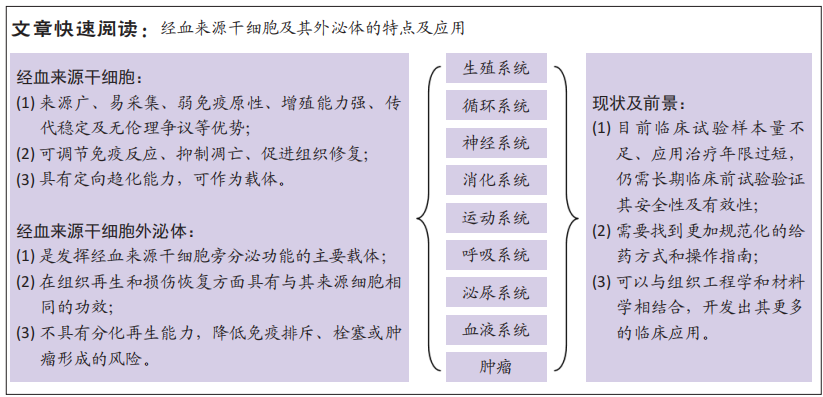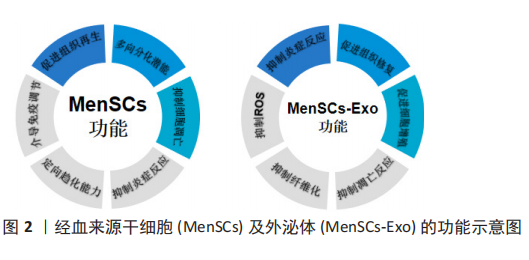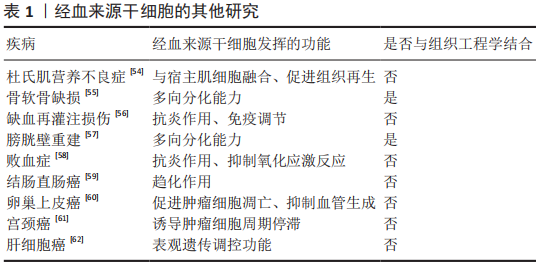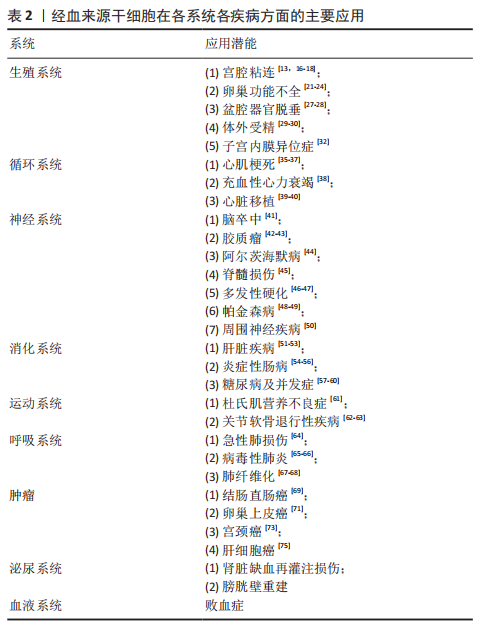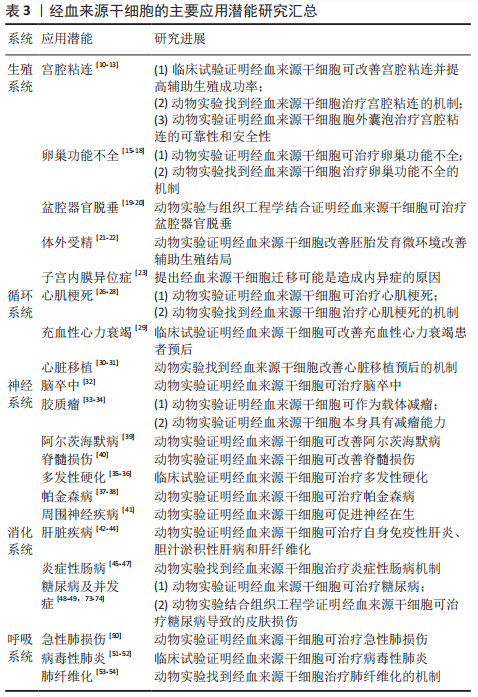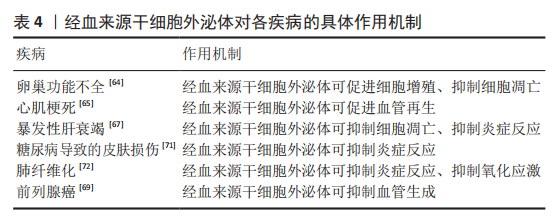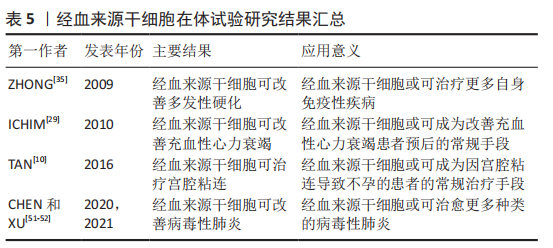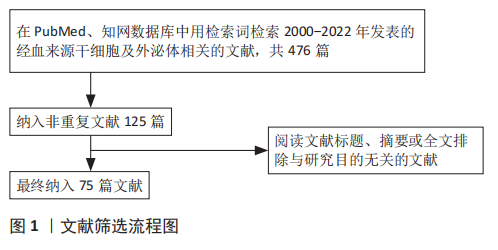[1] CRISAN M, YAP S, CASTEILLA L, et al. A perivascular origin for mesenchymal stem cells in multiple human organs. Cell Stem Cell. 2008;3(3):301-313.
[2] MENG X, ICHIM TE, ZHONG J, et al. Endometrial regenerative cells: a novel stem cell population. J Transl Med. 2007;5:57.
[3] BIDARIMATH M, KHALAJ K, KRIDLI RT, et al. Extracellular vesicle mediated intercellular communication at the porcine maternal-fetal interface: a new paradigm for conceptus-endometrial cross-talk. Sci Rep. 2017;7:40476.
[4] HUANG-DORAN I, ZHANG CY, VIDAL-PUIG A. Extracellular vesicles: Novel mediators of cell communication in metabolic disease. Trends Endocrinol Metab. 2017;28(1):3-18.
[5] 程贤鹦,周锦红.经血来源干细胞临床应用研究进展[J].中华临床医师杂志(电子版),2020,14(5):385-390.
[6] LV H, HU Y, CUI Z, et al. Human menstrual blood: a renewable and sustainable source of stem cells for regenerative medicine. Stem Cell Res Ther. 2018;9(1):325.
[7] LIU Y, NIU R, YANG F, et al. Biological characteristics of human menstrual blood-derived endometrial stem cells. J Cell Mol Med. 2018; 22(3):1627-1639.
[8] 谭季春,李雅璇,王秋实,等.利用月经血建立的经血源性基质干细胞系[J].中国组织工程研究,2015,19(50):8155-8160.
[9] 常琦圆.经血源性间充质干细胞来源外泌体治疗大鼠宫腔粘连的研究[D].沈阳:中国医科大学,2020.
[10] TAN J, LI P, WANG Q, et al. Autologous menstrual blood-derived stromal cells transplantation for severe asherman’s syndrome. Hum Reprod. 2016;31(12):2723-272910.
[11] ZHANG S, LI P, YUAN Z, et al. Platelet-rich plasma improves therapeutic effects of menstrual blood-derived stromal cells in rat model of intrauterine adhesion. Stem Cell Res Ther. 2019;10(1):61.
[12] ZHU H, PAN Y, JIANG Y, et al. Activation of the hippo/taz pathway is required for menstrual stem cells to suppress myofibroblast and inhibit transforming growth factor beta signaling in human endometrial stromal cells. Hum Reprod. 2019;34(4):635-645.
[13] ZHANG S, CHANG Q, LI P, et al. Concentrated small extracellular vesicles from menstrual blood-derived stromal cells improve intrauterine adhesion, a pre-clinical study in a rat model. Nanoscale. 2021;13(15): 7334-7347.
[14] CHEN JM, HUANG QY, ZHAO YX, et al. The latest developments in immunomodulation of mesenchymal stem cells in the treatment of intrauterine adhesions, both allogeneic and autologous. Front Immunol. 2021;12:785717.
[15] YAMCHI NN, RAHBARGHAZI R, BEDATE AM, et al. Menstrual blood cd146(+) mesenchymal stem cells reduced fibrosis rate in the rat model of premature ovarian failure. Cell Biochem Funct. 2021;39(8):998-1008.
[16] FENG P, LI P, TAN J. Human menstrual blood-derived stromal cells promote recovery of premature ovarian insufficiency via regulating the ecm-dependent fak/akt signaling. Stem Cell Rev Rep. 2019;15(2): 241-255.
[17] SUN F, WEI W. Effect of gnrh agonist combined with menstrual blood-derived stem cell transplantation on ovarian function in mice. Nan Fang Yi Ke Da Xue Xue Bao. 2021;41(12):1850-1856.
[18] LAI D, GUO Y, ZHANG Q, et al. Differentiation of human menstrual blood-derived endometrial mesenchymal stem cells into oocyte-like cells. Acta Biochim Biophys Sin (Shanghai). 2016;48(11):998-1005.
[19] SU K, EDWARDS SL, TAN KS, et al. Induction of endometrial mesenchymal stem cells into tissue-forming cells suitable for fascial repair. Acta Biomater. 2014;10(12):5012-5020.
[20] EMMERSON SJ, GARGETT CE. Endometrial mesenchymal stem cells as a cell based therapy for pelvic organ prolapse. World J Stem Cells. 2016;8(5):202-215.
[21] GONçALVES MF, ASENSI KD, NASCIMENTO ALL, et al. Human menstrual blood-derived mesenchymal cells improve mouse embryonic development. Tissue Eng Part A. 2020;26(13-14):769-779.
[22] BLAZQUEZ R, SANCHEZ-MARGALLO FM, ALVAREZ V, et al. Murine embryos exposed to human endometrial mscs-derived extracellular vesicles exhibit higher vegf/pdgf aa release, increased blastomere count and hatching rates. PLoS One. 2018;13(4):e0196080.
[23] 常琦圆,谭季春.经血源性间充质干细胞生物学特性及在组织修复重建中的临床应用[J].中国组织工程研究,2019,23(21):3432-3438
[24] PROESTLING K, BIRNER P, BALENDRAN S, et al. Enhanced expression of the stemness-related factors oct4, sox15 and twist1 in ectopic endometrium of endometriosis patients. Reprod Biol Endocrinol. 2016; 14(1):81.
[25] YERLIKAYA G, BALENDRAN S, PROSTLING K, et al. Comprehensive study of angiogenic factors in women with endometriosis compared to women without endometriosis. Eur J Obstet Gynecol Reprod Biol. 2016;204:88-98.
[26] HIDA N, NISHIYAMA N, MIYOSHI S, et al. Novel cardiac precursor-like cells from human menstrual blood-derived mesenchymal cells. Stem Cells. 2008;26(7):1695-1704.
[27] JIANG Z, HU X, YU H, et al. Human endometrial stem cells confer enhanced myocardial salvage and regeneration by paracrine mechanisms. J Cell Mol Med. 2013;17(10):1247-1260.
[28] ZHANG Z, WANG JA, XU Y, et al. Menstrual blood derived mesenchymal cells ameliorate cardiac fibrosis via inhibition of endothelial to mesenchymal transition in myocardial infarction. Int J Cardiol. 2013; 168(2):1711-1714.
[29] ICHIM TE, SOLANO F, LARA F, et al. Combination stem cell therapy for heart failure. Int Arch Med. 2010;3(1):5.
[30] XU X, LI X, GU X, et al. Prolongation of cardiac allograft survival by endometrial regenerative cells:Focusing on b-cell responses. Stem Cells Transl Med. 2017;6(3):778-78710.
[31] LAN X, WANG G, XU X, et al. Stromal cell-derived factor-1 mediates cardiac allograft tolerance induced by human endometrial regenerative cell-based therapy. Stem Cells Transl Med. 2017;6(11):1997-2008.
[32] BORLONGAN CV, KANEKO Y, MAKI M, et al. Menstrual blood cells display stem cell-like phenotypic markers and exert neuroprotection following transplantation in experimental stroke. Stem Cells Dev. 2010; 19(4):439-4521.
[33] WANG XJ, XIANG BY, DING YH, et al. Human menstrual blood-derived mesenchymal stem cells as a cellular vehicle for malignant glioma gene therapy. Oncotarget. 2017;8(35):58309-58321.
[34] HAN X, MENG X, YIN Z, et al. Inhibition of intracranial glioma growth by endometrial regenerative cells. Cell Cycle. 2009;8(4):606-610.
[35] ZHONG Z, PATEL AN, ICHIM TE, et al. Feasibility investigation of allogeneic endometrial regenerative cells. J Transl Med. 2009;7:15.
[36] 高海瑶.经血源性子宫内膜干细胞对实验性自身免疫性脑脊髓炎的治疗效果及作用机制研究[D].新乡:新乡医学院,2019.
[37] LI H, YAHAYA BH, NG WH, et al. Conditioned medium of human menstrual blood-derived endometrial stem cells protects against mpp(+)-induced cytotoxicity in vitro. Front Mol Neurosci. 2019;12:80.
[38] WOLFF EF, GAO XB, YAO KV, et al. Endometrial stem cell transplantation restores dopamine production in a parkinson’s disease model. J Cell Mol Med. 2011;15(4):747-755.
[39] ZHAO Y, CHEN X, WU Y, et al. Transplantation of human menstrual blood-derived mesenchymal stem cells alleviates alzheimer’s disease-like pathology in app/ps1 transgenic mice. Front Mol Neurosci. 2018; 11:140.
[40] WU Q, WANG Q, LI Z, et al. Human menstrual blood-derived stem cells promote functional recovery in a rat spinal cord hemisection model. Cell Death Dis. 2018;9(9):882.
[41] FARZAMFAR S, NASERI-NOSAR M, GHANAVATINEJAD A, et al. Sciatic nerve regeneration by transplantation of menstrual blood-derived stem cells. Mol Biol Rep. 2017;44(5):407-41210.
[42] WANG H, ZHAO Y, REN B, et al. Endometrial regenerative cells with galectin-9 high-expression attenuate experimental autoimmune hepatitis. Stem Cell Res Ther. 2021;12(1):541.
[43] LI G, KONG D, QIN Y, et al. Il-37 overexpression enhances the therapeutic effect of endometrial regenerative cells in concanavalin a-induced hepatitis. Cytotherapy. 2021;23(7):617-626.
[44] YANG Y, CHEN Y, ZHAO Y, et al. Human menstrual blood-derived stem cell transplantation suppresses liver injury in ddc-induced chronic cholestasis. Stem Cell Res Ther. 2022;13(1):57.
[45] XU X, WANG Y, ZHANG B, et al. Treatment of experimental colitis by endometrial regenerative cells through regulation of b lymphocytes in mice. Stem Cell Res Ther. 2018;9(1):146.
[46] SHI G, WANG G, LU S, et al. Pd-l1 is required for human endometrial regenerative cells-associated attenuation of experimental colitis in mice. Am J Transl Res. 2019;11(8):4696-4712.
[47] LI X, LAN X, ZHAO Y, et al. Sdf-1/cxcr4 axis enhances the immunomodulation of human endometrial regenerative cells in alleviating experimental colitis. Stem Cell Res Ther. 2019;10(1):204.
[48] SUN YL, SHANG LR, LIU RH, et al. Therapeutic effects of menstrual blood-derived endometrial stem cells on mouse models of streptozotocin-induced type 1 diabetes. World J Stem Cells. 2022;14(1): 104-116.
[49] MIRZADEGAN E, GOLSHAHI H, SAFFARIAN Z, et al. The remarkable effect of menstrual blood stem cells seeded on bilayer scaffold composed of amniotic membrane and silk fibroin aiming to promote wound healing in diabetic mice. Int Immunopharmacol. 2022;102:108404.
[50] XIANG B, CHEN L, WANG X, et al. Transplantation of menstrual blood-derived mesenchymal stem cells promotes the repair of lps-induced acute lung injury. Int J Mol Sci. 2017;18(4):689.
[51] XU X, JIANG W, CHEN L, et al. Evaluation of the safety and efficacy of using human menstrual blood-derived mesenchymal stromal cells in treating severe and critically ill covid-19 patients: an exploratory clinical trial. Clin Transl Med. 2021;11(2):e297.
[52] CHEN J, HU C, CHEN L, et al. Clinical study of mesenchymal stem cell treatment for acute respiratory distress syndrome induced by epidemic influenza a (h7n9) infection: a hint for covid-19 treatment. Engineering (Beijing, China). 2020;6(10):1153-116110.
[53] CHEN X, WU Y, WANG Y, et al. Human menstrual blood-derived stem cells mitigate bleomycin-induced pulmonary fibrosis through anti-apoptosis and anti-inflammatory effects. Stem Cell Res Ther. 2020; 11(1):477.
[54] ZHAO Y, LAN X, WANG Y, et al. Human endometrial regenerative cells attenuate bleomycin-induced pulmonary fibrosis in mice. Stem Cells Int. 2018;2018:3475137.
[55] CUI CH, UYAMA T, MIYADO K, et al. Menstrual blood-derived cells confer human dystrophin expression in the murine model of duchenne muscular dystrophy via cell fusion and myogenic transdifferentiation. Mol Biol Cell. 2007;18(5):1586-1594.
[56] KHANMOHAMMADI M, GOLSHAHI H, SAFFARIAN Z, et al. Repair of osteochondral defects in rabbit knee using menstrual blood stem cells encapsulated in fibrin glue: a good stem cell candidate for the treatment of osteochondral defects. Tissue Eng Regen Med. 2019; 16(3):311-324.
[57] SUN P, LIU J, LI W, et al. Human endometrial regenerative cells attenuate renal ischemia reperfusion injury in mice. J Transl Med. 2016; 14:28.
[58] SHOAE-HASSANI A, MORTAZAVI-TABATABAEI SA, SHARIF S, et al. Differentiation of human endometrial stem cells into urothelial cells on a three-dimensional nanofibrous silk-collagen scaffold: an autologous cell resource for reconstruction of the urinary bladder wall. J Tissue Eng Regen Med. 2015;9(11):1268-1276.
[59] JIN W, ZHAO Y, HU Y, et al. Stromal cell-derived factor-1 enhances the therapeutic effects of human endometrial regenerative cells in a mouse sepsis model. Stem Cells Int. 2020;2020:4820543.
[60] GUO Y, ZHANG Z, XU X, et al. Menstrual blood-derived stem cells as delivery vehicles for oncolytic adenovirus virotherapy for colorectal cancer. Stem Cells Dev. 2019;28(13):882-896.
[61] BU S, WANG Q, ZHANG Q, et al. Human endometrial mesenchymal stem cells exhibit intrinsic anti-tumor properties on human epithelial ovarian cancer cells. Sci Rep. 2016;6:37019.
[62] LIU QY, RUAN F, LI JY, et al. Human menstrual blood-derived stem cells inhibit the proliferation of hela cells via tgf-beta1-mediated jnk/p21 signaling pathways. Stem Cells Int. 2019;2019:9280298.
[63] WU Y, CHEN X, ZHAO Y, et al. Genome-wide DNA methylation and hydroxymethylation analysis reveal human menstrual blood-derived stem cells inhibit hepatocellular carcinoma growth through oncogenic pathway suppression via regulating 5-hmc in enhancer elements. Stem Cell Res Ther. 2019;10(1):151.
[64] ZHANG S, HUANG B, SU P, et al. Concentrated exosomes from menstrual blood-derived stromal cells improves ovarian activity in a rat model of premature ovarian insufficiency. Stem Cell Res Ther. 2021;12(1):178.
[65] WANG K, JIANG Z, WEBSTER KA, et al. Enhanced cardioprotection by human endometrium mesenchymal stem cells driven by exosomal microrna-21. Stem Cells Transl Med. 2017;6(1):209-222.
[66] SHAFEI AE, ALI MA, GHANEM HG, et al. Mesenchymal stem cell therapy: a promising cell-based therapy for treatment of myocardial infarction. J Gene Med. 2017;19(12):2995.
[67] CHEN L, XIANG B, WANG X, et al. Exosomes derived from human menstrual blood-derived stem cells alleviate fulminant hepatic failure. Stem Cell Res Ther. 2017;8(1):9.
[68] SHI M, ZHANG Z, XU R, et al. Human mesenchymal stem cell transfusion is safe and improves liver function in acute-on-chronic liver failure patients. Stem Cells Transl Med. 2012;1(10):725-731.
[69] ALCAYAGA-MIRANDA F, GONZALEZ PL, LOPEZ-VERRILLI A, et al. Prostate tumor-induced angiogenesis is blocked by exosomes derived from menstrual stem cells through the inhibition of reactive oxygen species. Oncotarget. 2016;7(28):44462-44477.
[70] ROSENBERGER L, EZQUER M, LILLO-VERA F, et al. Stem cell exosomes inhibit angiogenesis and tumor growth of oral squamous cell carcinoma. Sci Rep. 2019;9(1):663.
[71] DALIRFARDOUEI R, JAMIALAHMADI K, JAFARIAN AH, et al. Promising effects of exosomes isolated from menstrual blood-derived mesenchymal stem cell on wound-healing process in diabetic mouse model. J Tissue Eng Regen Med. 2019;13(4):555-568.
[72] SUN L, ZHU M, FENG W, et al. Exosomal mirna let-7 from menstrual blood-derived endometrial stem cells alleviates pulmonary fibrosis through regulating mitochondrial DNA damage. Oxid Med Cell Longev. 2019;2019:4506303.
[73] FARAMARZI H, MEHRABANI D, FARD M, et al. The potential of menstrual blood-derived stem cells in differentiation to epidermal lineage: a preliminary report. World journal of plastic surgery. 2016; 5(1):26-31.
[74] AKHAVAN-TAVAKOLI M, FARD M, KHANJANI S, et al. In vitro differentiation of menstrual blood stem cells into keratinocytes: a potential approach for management of wound healing. Biologicals. 2017;48:66-73.
[75] CHANG QY, ZHANG SW, LI PP, et al. Safety of menstrual blood-derived stromal cell transplantation in treatment of intrauterine adhesion. World J Stem Cells. 2020;12(5):368-380. |
